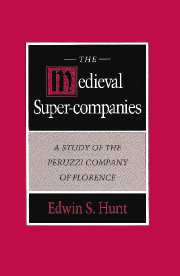Book contents
- Frontmatter
- Contents
- List of tables, figures, and map
- Introduction
- Part I Anatomy of the medieval super-company
- 1 The company and the family
- 2 The nature of the business
- 3 The structure of the Peruzzi Company
- 4 The accounting of the Peruzzi Company
- Part II History of the Peruzzi Company from its reorganization in 1300
- Conclusions
- Appendixes
- Bibliography
- Index
3 - The structure of the Peruzzi Company
Published online by Cambridge University Press: 08 October 2009
- Frontmatter
- Contents
- List of tables, figures, and map
- Introduction
- Part I Anatomy of the medieval super-company
- 1 The company and the family
- 2 The nature of the business
- 3 The structure of the Peruzzi Company
- 4 The accounting of the Peruzzi Company
- Part II History of the Peruzzi Company from its reorganization in 1300
- Conclusions
- Appendixes
- Bibliography
- Index
Summary
The medieval super-companies, like most companies of significant size, were organized legally as quasi-permanent multiple partnerships. They were quasi-permanent in that they did not dissolve with the death or retirement of a partner, and even upon “dissolution” of the partnership they were immediately renewed. Each partnership lasted as long as it suited the partners; some were closed and profits distributed after two years, while others continued for as many as twelve years. The main purpose of closing a partnership was to effect a new alignment of shareholdings, usually, but not always accompanied by a formal distribution of profit. Whatever the reasons for closure, the business continued without interruption. Partnerships were multiple, with as many as twenty-one partners in the 1331 Peruzzi Company, each contributing a specific amount of money. The money values constituted share ownership, which entitled each owner to a share of profit or loss prorated to the percentage of his contribution to total company capital. Thus, the word “shareholder” can be used interchangeably with the word “partner.” The companies were partnerships in the sense that each shareholder was subject to unlimited liability against all of his personal possessions in case of bankruptcy. Any distribution of profit was therefore tentative, subject to subsequent positive or negative adjustments years or even decades after the original distributions.
The super-companies' intended permanence is attested by the fact that none was terminated voluntarily. This sense of permanence was enhanced by the use of a company logo, such as the golden pears on a blue background in the case of the Peruzzi and the diamond-shaped heraldic design of the Bardi.
- Type
- Chapter
- Information
- The Medieval Super-CompaniesA Study of the Peruzzi Company of Florence, pp. 76 - 100Publisher: Cambridge University PressPrint publication year: 1994



